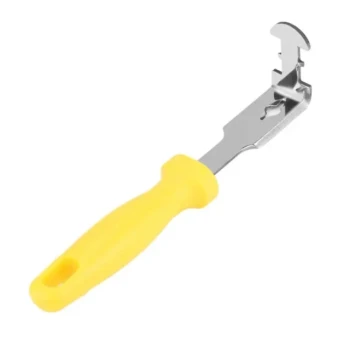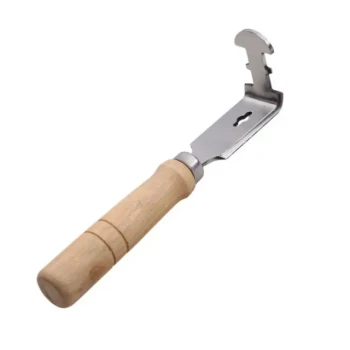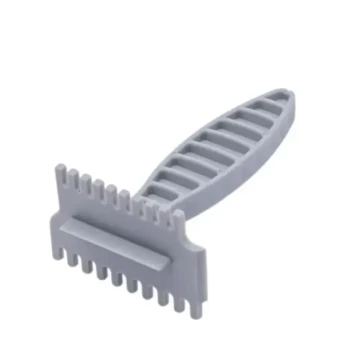As a general rule, the area directly under and around your beehives should be inspected and cleaned monthly during the warm, active season. This frequency can be adjusted based on your local climate and specific pest pressures, such as the presence of Small Hive Beetles.
The core purpose of under-hive maintenance is not simple tidiness; it is a critical practice for integrated pest management. By keeping this area clear, you disrupt pest life cycles, reduce excess moisture, and create a healthier, more defensible environment for your colony.
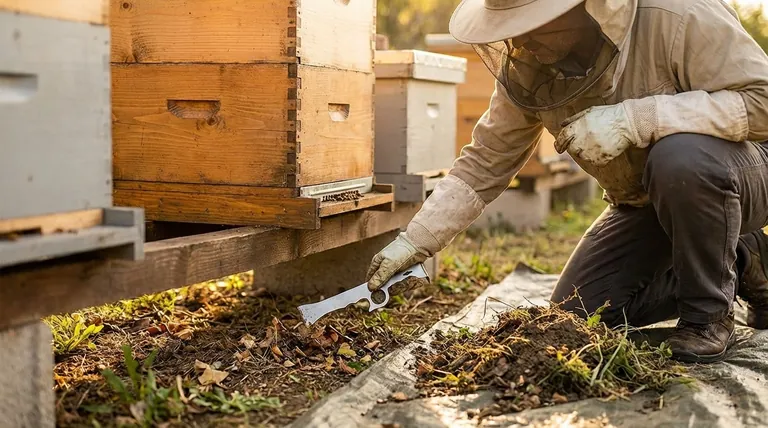
Why Under-Hive Maintenance is Critical for Colony Health
Maintaining the ground beneath a hive is a simple task that has a significant impact on the overall well-being of the colony. It directly influences their ability to defend against common threats.
Disrupting Pest Life Cycles
Many common hive pests, most notably the Small Hive Beetle (SHB), use the soil directly in front of and under the hive to complete their life cycle. SHB larvae crawl out of the hive and burrow into the soil to pupate.
A clean, clear area exposes these vulnerable larvae and pupae to predators like ants and birds, and to desiccation from the sun. Debris, leaves, and overgrown grass provide the perfect cover for them to pupate successfully.
Reducing Moisture and Fungal Growth
Tall weeds and grass trap moisture at the ground level, creating a humid microclimate beneath the hive. This constant dampness can accelerate the rotting of wooden hive components, especially the bottom board.
Furthermore, this excess moisture can increase the overall humidity inside the hive, making it harder for bees to regulate their environment and potentially promoting the growth of mold and fungus.
Ensuring Proper Ventilation
Proper airflow is essential for a colony to manage temperature and cure honey. Overgrown vegetation can easily block hive entrances or the mesh of a screened bottom board.
Obstructed ventilation traps stale, moist air inside the hive, increasing stress on the colony and making them more susceptible to disease.
A Practical Inspection Cadence
Your maintenance schedule should be consistent but flexible enough to adapt to changing conditions in your apiary.
The Monthly Warm-Season Check
During the active season (spring and summer), a monthly inspection is a sufficient baseline. This quick check can be integrated with your regular hive inspections.
The goal is to pull any weeds, rake away fallen leaves or debris, and ensure the ground is clear and drains well.
When to Increase Frequency
You should increase your inspection frequency to bi-weekly if you notice specific threats. A high population of Small Hive Beetles within the hive is a clear signal to become more aggressive with ground maintenance.
Similarly, periods of heavy rain or exceptionally fast vegetation growth warrant more frequent checks to prevent the area from becoming overgrown and damp.
Common Pitfalls to Avoid
While this task is straightforward, a couple of common missteps can undermine your efforts or even harm your bees.
The Risk of Neglect
Simply ignoring the area under the hive is the most common pitfall. A small weed problem can quickly become an overgrown mess that provides a safe harbor for pests and traps moisture against the hive.
This neglect creates unnecessary stress on the colony, forcing them to deal with preventable threats that divert resources from foraging and brood-rearing.
The Danger of Chemical Use
Never use herbicides, pesticides, or chemical soil treatments directly around your hives. These substances can be tracked back into the hive by foraging bees, potentially contaminating the honey and harming or killing the colony.
Stick to manual methods like hand-pulling, weed-eating (with care not to agitate the bees), or laying down simple barriers like cardboard or mulch.
Making the Right Choice for Your Goal
Your specific environment dictates the ideal frequency and focus of your under-hive maintenance routine.
- If your primary focus is controlling Small Hive Beetles: Inspect bi-weekly during warm months, keeping the ground bare and exposed to the sun to disrupt their pupation cycle.
- If your primary focus is managing moisture in a damp climate: Perform monthly checks to ensure vegetation is cut low, promoting maximum airflow and allowing the ground to dry out.
- If your primary focus is general hive health in a dry climate: A standard monthly inspection to clear weeds and debris is perfectly adequate to maintain a clean and defensible space.
Consistent ground maintenance is one of the simplest and most effective ways to support your colony's long-term health and resilience.
Summary Table:
| Situation | Recommended Frequency | Key Focus |
|---|---|---|
| General Warm Season Maintenance | Monthly | Clear weeds, debris, ensure good drainage |
| High Small Hive Beetle Pressure | Bi-weekly | Disrupt pest life cycle by keeping ground bare |
| Damp Climate / Heavy Rain | Bi-weekly | Manage moisture, promote airflow, prevent mold |
| Dry Climate / General Health | Monthly | Maintain clean, defensible space |
Equip Your Apiary for Success with HONESTBEE
Consistent under-hive maintenance is a cornerstone of integrated pest management, but having the right equipment makes the job easier and more effective. At HONESTBEE, we supply commercial apiaries and beekeeping equipment distributors with durable, wholesale-focused beekeeping supplies designed to support healthy, productive colonies.
From screened bottom boards that enhance ventilation to sturdy hive stands that simplify ground clearing, our products are built to help you implement best practices efficiently. Ready to strengthen your pest management strategy? Contact our team today to discuss your wholesale needs and discover how HONESTBEE can be your trusted partner in beekeeping success.
Visual Guide
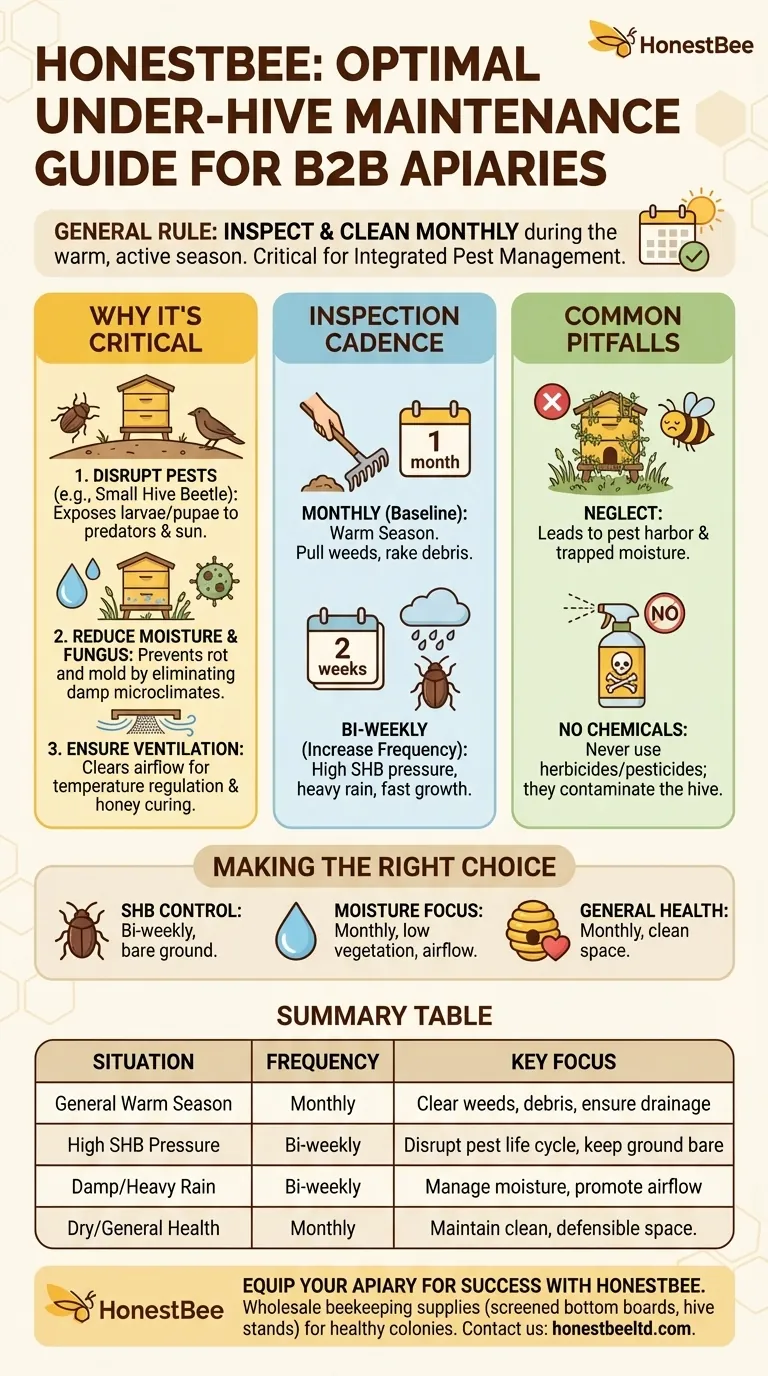
Related Products
- HONESTBEE Advanced Ergonomic Stainless Steel Hive Tool for Beekeeping
- Professional Dual-End Stainless Steel Hive Tool for Beekeeping
- Professional 3-Bar Frame Grip with Integrated Hive Tool
- Heavy Duty Stainless Steel Frame Cleaner with Plastic Handle
- Professional Galvanized Hive Strap with Secure Locking Buckle for Beekeeping
People Also Ask
- How should beekeepers handle bees when using a hive tool? Master Calm, Deliberate Techniques
- What is the hole in a hive tool for? A Multi-Tool for Apiary Repairs and Maintenance
- What are the basic tools for beekeeping? Essential Starter Kit for Safe & Successful Hive Management
- What is a hive tool and what are its uses? Master Your Hive Inspections with the Essential Beekeeper's Tool
- Why is it important to compare the progress of different hives? A Beekeeper's Key Diagnostic Tool



